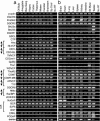A comprehensive analysis of 22q11 gene expression in the developing and adult brain
- PMID: 14614146
- PMCID: PMC283609
- DOI: 10.1073/pnas.2235651100
A comprehensive analysis of 22q11 gene expression in the developing and adult brain
Abstract
Deletions at 22q11.2 are linked to DiGeorge or velocardiofacial syndrome (VCFS), whose hallmarks include heart, limb, and craniofacial anomalies, as well as learning disabilities and increased incidence of schizophrenia. To assess the potential contribution of 22q11 genes to cognitive and psychiatric phenotypes, we determined the CNS expression of 32 mouse orthologs of 22q11 genes, primarily in the 1.5-Mb minimal critical region consistently deleted in VCFS. None are uniquely expressed in the developing or adult mouse brain. Instead, 27 are localized in the embryonic forebrain as well as aortic arches, branchial arches, and limb buds. Each continues to be expressed at apparently constant levels in the fetal, postnatal, and adult brain, except for Tbx1, ProDH2, and T10, which increase in adolescence and decline in maturity. At least six 22q11 proteins are seen primarily in subsets of neurons, including some in forebrain regions thought to be altered in schizophrenia. Thus, 22q11 deletion may disrupt expression of multiple genes during development and maturation of neurons and circuits compromised by cognitive and psychiatric disorders associated with VCFS.
Figures





References
-
- van Amelsvoort, T., Daly, E., Robertson, D., Suckling, J., Ng, V., Critchley, H., Owen, M. J., Henry, J., Murphy, K. C. & Murphy, D. G. (2001) Br. J. Psychiatry 178, 412-419. - PubMed
-
- Chieffo, C., Garvey, N., Gong, W., Roe, B., Zhang, G., Silver, L., Emanuel, B. S. & Budarf, M. L. (1997) Genomics 43, 267-277. - PubMed
Publication types
MeSH terms
Grants and funding
LinkOut - more resources
Full Text Sources
Other Literature Sources
Molecular Biology Databases
Research Materials
Miscellaneous

